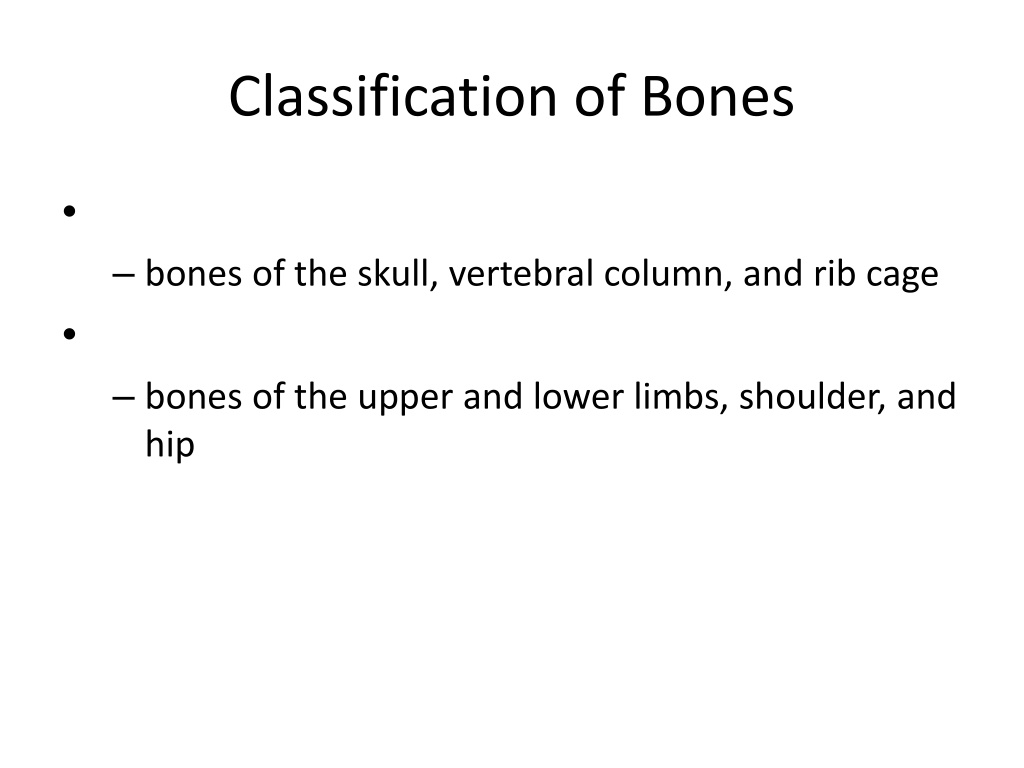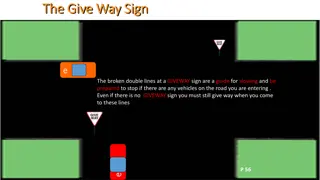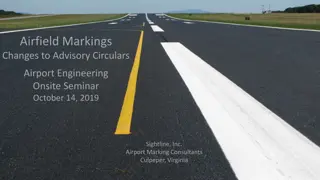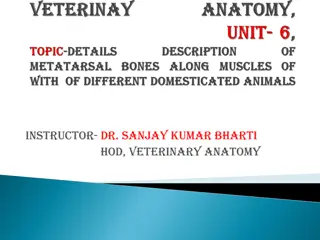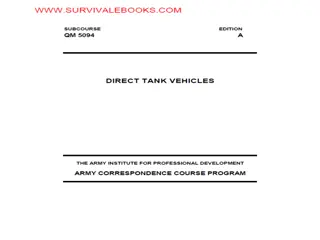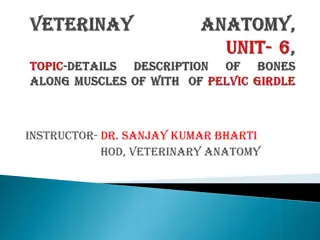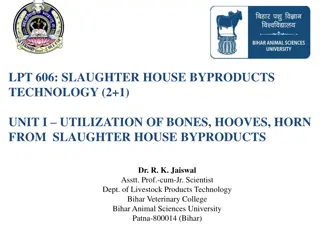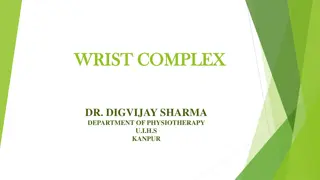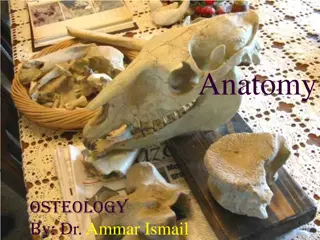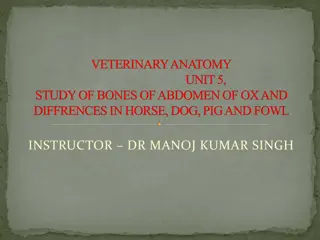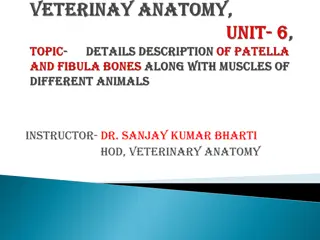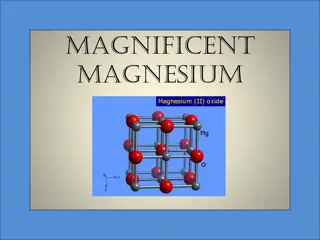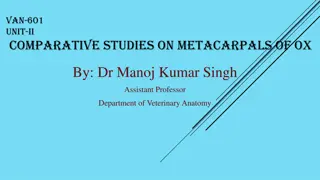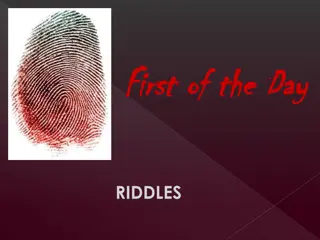Understanding Bones: Classification, Functions, and Markings
Explore the classification of bones based on shape, learn about the functions of bones in supporting the body and protecting vital organs, and understand the different bone markings that serve as attachment sites and joint formations.
Download Presentation

Please find below an Image/Link to download the presentation.
The content on the website is provided AS IS for your information and personal use only. It may not be sold, licensed, or shared on other websites without obtaining consent from the author. Download presentation by click this link. If you encounter any issues during the download, it is possible that the publisher has removed the file from their server.
E N D
Presentation Transcript
Classification of Bones bones of the skull, vertebral column, and rib cage bones of the upper and lower limbs, shoulder, and hip
Classification of Bones: By Shape longer than they are wide
Classification of Bones: By Shape Cube-shaped bones of the _ Bones that form within tendons _ Figure 6.2b
Classification of Bones: By Shape thin, flattened, and a bit curved most Figure 6.2c
Classification of Bones: By Shape bones with complicated shapes Figure 6.2d
Function of Bones form the framework that supports the body and cradles soft organs provide a protective case for the brain, spinal cord, and vital organs provide levers for muscles
Function of Bones reservoir for minerals, especially calcium and phosphorus hematopoiesis occurs within the marrow cavities of bones
Bone Markings Bulges, depressions, and holes that serve as: Joint surfaces Conduits for blood vessels and nerves
Bone Markings: Projections Sites of Muscle and Ligament Attachment rounded projection small rounded projection narrow, prominent ridge of bone raised area above a condyle large, blunt, irregular surface sharp, slender projection any bony prominence narrow ridge of bone
Bone Markings: Projections Projections That Help to Form Joints bony expansion carried on a narrow neck smooth, nearly flat articular surface rounded articular projection arm-like bar of bone
Bone Markings: Depressions and Openings canal-like passageway furrow cavity within a bone narrow, slit-like opening shallow, basin-like depression round or oval opening through a bone
Bone Textures Compact bone Spongy bone honeycomb of trabeculae _
Structure of Long Bone Long bones consist of a _ Diaphysis Tubular shaft Composed of _ surrounds the medullary cavity Yellow bone marrow in the medullary cavity
Structure of Long Bone Epiphyses ________________________________ of long bones Exterior is compact bone, and the _ Joint surface is covered with articular (hyaline) cartilage Epiphyseal line separates the diaphysis from the epiphyses
Bone Membranes ______________________________ double-layered protective membrane Richly supplied with nerve fibers, blood, and lymphatic vessels, which enter the bone via _ Secured to underlying bone by _
Bone Membranes delicate membrane covering internal surfaces of bone
Structure of Short, Irregular, and Flat Bones Thin plates of periosteum-covered compact bone on the outside with endosteum-covered spongy bone on the inside Have _ Contain bone marrow between the trabeculae
Location of Hematopoietic Tissue (Red Marrow) In infants Found in the _ all areas of spongy bone In adults Found in the _ the head of the femur the head of the _
Microscopic Structure of Bone: Compact Bone _________________________, or osteon the structural unit of compact bone weight-bearing, column-like matrix tubes composed mainly of collagen Haversian, or _ containing blood vessels and nerves channels lying at right angles to the central canal, connecting blood and nerve supply of the periosteum to that of the Haversian canal
Microscopic Structure of Bone: Compact Bone Osteocytes Lacunae ______________________________ in bone that _ Canaliculi ___________________________________ that connect lacunae to each other and the central canal
Chemical Composition of Bone: Organic Osteoblasts Osteocytes mature bone cells Osteoclasts large cells that resorb or _
Bone Development Osteogenesis and ossification the _________________________________, which leads to: The formation of the bony skeleton in embryos Bone growth until early adulthood Bone thickness, _
Formation of the Bony Skeleton Begins at ______________________ of embryo development Intramembranous ossification bone develops from a _ Endochondral ossification bone forms by _
Intramembranous Ossification Formation of most of the _
Stages of IntramembranousOssification An _____________________________ appears in the fibrous connective tissue membrane Bone matrix is secreted within the fibrous membrane Woven bone and periosteum form Bone collar of _
Stages of Intramembranous Ossification Figure 6.7.1
Stages of Intramembranous Ossification Figure 6.7.2
Stages of Intramembranous Ossification Figure 6.7.3
Stages of Intramembranous Ossification Figure 6.7.4
Endochondral Ossification Begins in the _ Uses ____________________________ as models for bone construction Requires breakdown of hyaline cartilage prior to ossification
Stages of Endochondral Ossification Formation of bone collar Cavitation of the hyaline cartilage spongy bone formation Formation of the medullary cavity; appearance of _ Ossification of the epiphyses, with hyaline cartilage remaining only in the epiphyseal plates
Postnatal Bone Growth Growth in length of long bones Cells of the epiphyseal plate proximal to the resting cartilage form three functionally different zones:
Functional Zones in Long Bone Growth Growth zone ____________________________________, pushing the epiphysis away from the diaphysis Transformation zone older cells enlarge, the matrix becomes calcified, cartilage cells die, and the _ Osteogenic zone new _
Hormonal Regulation of Bone Growth During Youth During infancy and childhood, epiphyseal plate activity is stimulated by _ During puberty, _ Initially promote adolescent growth spurts Later induce epiphyseal ___________________________, ending longitudinal bone growth
